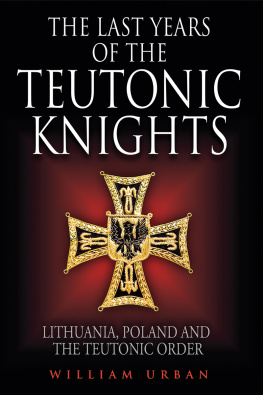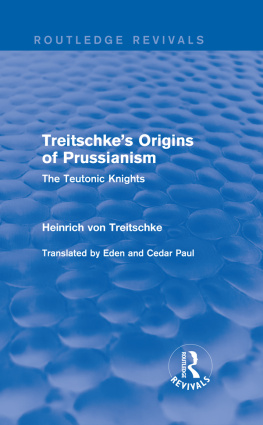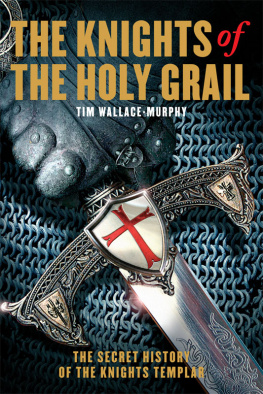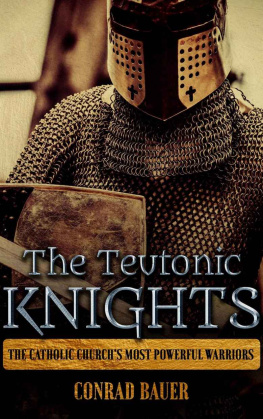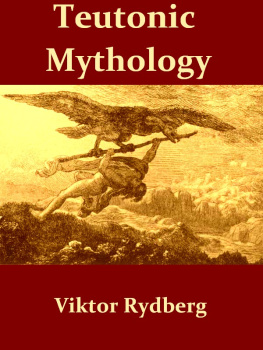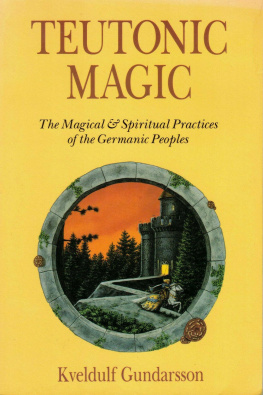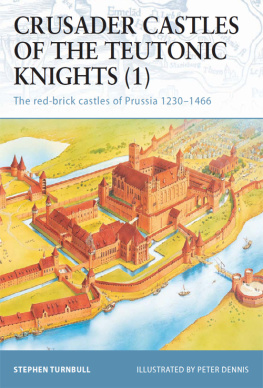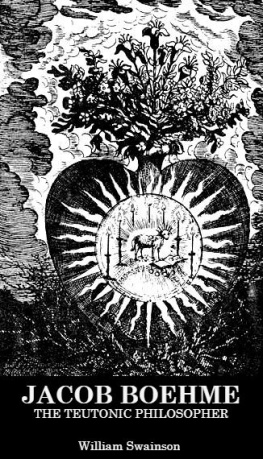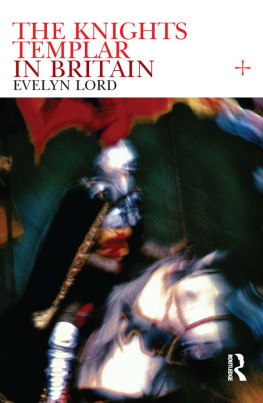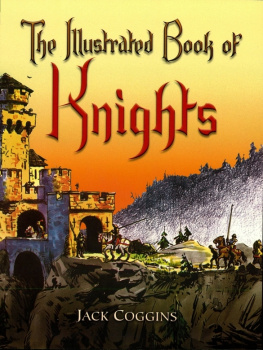William Urban - The Last Years of the Teutonic Knights
Here you can read online William Urban - The Last Years of the Teutonic Knights full text of the book (entire story) in english for free. Download pdf and epub, get meaning, cover and reviews about this ebook. year: 2018, publisher: Casemate Publishers & Book Distributors, LLC, genre: Non-fiction. Description of the work, (preface) as well as reviews are available. Best literature library LitArk.com created for fans of good reading and offers a wide selection of genres:
Romance novel
Science fiction
Adventure
Detective
Science
History
Home and family
Prose
Art
Politics
Computer
Non-fiction
Religion
Business
Children
Humor
Choose a favorite category and find really read worthwhile books. Enjoy immersion in the world of imagination, feel the emotions of the characters or learn something new for yourself, make an fascinating discovery.
- Book:The Last Years of the Teutonic Knights
- Author:
- Publisher:Casemate Publishers & Book Distributors, LLC
- Genre:
- Year:2018
- Rating:3 / 5
- Favourites:Add to favourites
- Your mark:
- 60
- 1
- 2
- 3
- 4
- 5
The Last Years of the Teutonic Knights: summary, description and annotation
We offer to read an annotation, description, summary or preface (depends on what the author of the book "The Last Years of the Teutonic Knights" wrote himself). If you haven't found the necessary information about the book — write in the comments, we will try to find it.
The Last Years of the Teutonic Knights — read online for free the complete book (whole text) full work
Below is the text of the book, divided by pages. System saving the place of the last page read, allows you to conveniently read the book "The Last Years of the Teutonic Knights" online for free, without having to search again every time where you left off. Put a bookmark, and you can go to the page where you finished reading at any time.
Font size:
Interval:
Bookmark:

LITHUANIA, POLAND AND THE TEUTONIC ORDER
WILLIAM URBAN

Greenhill Books
The Last Years of the Teutonic Knights
First published in 2019 by
Greenhill Books,
c/o Pen & Sword Books Ltd,
47 Church Street, Barnsley,
S. Yorkshire, S70 2AS
www.greenhillbooks.com
ISBN: 9781784383572
eISBN: 9781784383589
Mobi ISBN: 9781784383596
All rights reserved.
William Urban, 2019
The right of William Urban to be identified as author of this work
has been asserted in accordance with Section 77 of
the Copyrights Designs and Patents Act 1988.
CIP data records for this title are available from the British Library
Charles IV (131678), king of Bohemia and Holy Roman emperor, by an unknown artist, 1371. (Wikimedia Commons/National Gallery, Prague)
Jagieo, by the PolishLithuanian painter Konstanty Aleksandrowicz. (Wikimedia Commons/Wisielec.97)
The Emperor Sigismund, by Albrecht Drer. (Wikimedia Commons/ Germanisches Nationalmuseum, Nuremberg)
Vytautas the Great in a seventeenth-century painting. (Wikimedia Commons/Vilnius Picture Gallery/Mareczko)
The battle of Nicopolis (1396) by a French miniaturist. (Wikimedia Commons/Bibliothque nationale de France)
Prisoners at the battle of Nicopolis in an illustration for Froissarts Chronicles. (Wikimedia Commons/Bibliothque nationale de France)
The city walls of Visby. (Wikimedia Commons/En-cas-de-soleil)
Knigsberg in the 1600s, strongly fortified for protection from the numerous wars of that era. (Wikimedia Commons)
Jan Matejkos painting of the battle of Tannenberg. (Wikimedia Commons/National Museum, Warsaw)
Jadwiga, daughter of Jagieo, by a German painter of the school of Mair von Landshut. (Wikimedia Commons/Burg Trausnitz, Landshut/ www.culture.pl )
Sophia Jagiellon, daughter of Casimir IV, by an unknown fifteenth-century painter. (Wikimedia Commons)
Marienburg castle from the Nogat River. (Wikimedia Commons/ Gregy)
The island castle at Trakai. (Wikimedia Commons/Leon Petrosyan)
The Old Town Hall of Thorn. (Wikimedia Commons/Piotr Kourno)
Friedrich of Hohenzollern entering Constance, from Richtenthals Chronicle . (Wikimedia Commons/Rosgartenmuseum, Constance)
The great beast brought from Lithuania, from Richtenthals Chronicle . (Wikimedia Commons/Rosgartenmuseum, Constance)
Meeting of the Council of Constance. (Wikimedia Commons/Rosgartenmuseum, Constance)
Sigismund I of Poland, by the anonymous painter PF. (Wikimedia Commons/Royal Castle Museum, Warsaw)
St Casimir of Poland by Daniel Schultz the Younger. (Wikimedia Commons/St Casimir Church, Cracow/BurgererSF)
Martin Truchse von Wetzhausen. (Wikimedia Commons/National Library, Austria)
Duke Albrecht of Brandenburg-Ansbach, by Lucas Cranach the Elder. (Wikimedia Commons/Herzog Anton Ulrich Museum, Brunswick/Cranach Digital Archive)
Coats of arms of the grandmasters of the Teutonic Order. (Wikimedia Commons/ Stiftsbibliothek, St Gallen/ www.e-codices.unifr.ch )
East-Central Europe in the Late 1300s
Lithuania in the Late 1300s
Baltic Trade Routes
Samogitia under the Teutonic Order
Germany, Poland and Lithuania in the 1400s
Bohemia and the Hussites
Royal Prussia and its Neighbours
This volume is an adaptation of Tannenberg and After, which was published in 1999 (with a revised edition in 2002) by the Lithuanian Research and Studies Center in Chicago. I have fond memories of working with Jonas Rackauskas, Bob Vitas and the other members of the staff. We took no pay for the project, being more interested in bringing the complicated and fascinating story of the Baltic Crusades to the public than in any money we could get from a limited print run. I thank the LRSC for ceding to me its share of the copyright and wishing this publication success.
I also want to thank the Lithuanian government for its support of my books, translating several into Lithuanian, including Tannenberg and After in 2004 as algiris ir kas po jo. Those also sold out quickly. Then there is Michael Leventhal and his father, at Greenhill Books, for printing the one-volume history that has been so well received. The Teutonic Knights has been translated into Polish, Lithuanian, Hungarian, Swedish, Italian, Portuguese and Russian.
There are so many to thank, and so many are now deceased. My dissertation adviser at the University of Texas, Archie Lewis, who taught me to think broadly and write boldly. Monmouth College, where I taught for half a century, for allowing me to teach over fifty different classes, thereby further broadening my education; and for the frequent sabbaticals that allowed me to do research in the pre-Web era. The Fulbright Commission, for joining with the German-American Club in Hamburg in 1964, to provide a very fruitful year in Germany; then in 1975 awarding me a senior research grant to work at the Johann Gottfried Herder Institut in Marburg/Lahn, Germany. The Deutscher Akademische Austauschdienst (DAAD) for the grants that stretched my slender sabbatical pay enough that I could take my family to Marburg/Lahn three times for research. Pope John Paul II for inviting me to speak at the conference on the 600th anniversary of the Christianisation of Lithuania, and his organisers Monsignor Maccaroni and Raffaele Farina. Friedrich Benninghoven, the director of the Geheimes Staatsarchivs Preussischer Kulturbesitz, for repeatedly encouraging me to keep working. Udo Arnold, the recipient of many well-deserved honours, for widening my interest to include more Polish history. Sven Ekdahl, for personal friendship as well as contributing so much to the scholarship of this era. The United States Military Academy, where I spent a month in 1985 enlarging my understanding of military history. The National Endowment for the Humanities for selecting me for three Summer Seminar programmes. The Journal of Baltic Studies which I edited for five years for including me in programmes in the Baltic States in the early nineties. The organisers of the Grunwald Conference in 2010, where I met again the foremost scholars of the history of this era. And my wife, Jackie, who accompanied me for many months in Germany, Italy, Yugoslavia and the Czech Republic; Germans knew that she was an Ausl nder because her German was accent-free and too perfect grammatically. And our three children who made life abroad even more enjoyable.
Lastly, I must thank John Freed, professor emeritus of Illinois State University, for his many suggestions for improvements in the text.
When I began work on the Teutonic Order, there were few scholars outside Germany and Poland publishing in the field. Happily, those scholars especially those in the Baltische Historische Kommission and the Historische Kommission fr ost-und westpreussische Landesforschung welcomed me into their ranks, even though my books have been aimed at a more popular audience.
I hope that my narrative will describe the events in a manner that can satisfy a wide range of contemporary scholarly opinion; at the least I hope that readers will neither be harmed nor bored.
William L. Urban,
Lee L. Morgan Professor of
History and International Studies
(retired), Monmouth College,
Illinois, USA
There is nothing more frustrating in the study of Central and Eastern Europe than deciding what names to use. Any choice will offend someone.
Font size:
Interval:
Bookmark:
Similar books «The Last Years of the Teutonic Knights»
Look at similar books to The Last Years of the Teutonic Knights. We have selected literature similar in name and meaning in the hope of providing readers with more options to find new, interesting, not yet read works.
Discussion, reviews of the book The Last Years of the Teutonic Knights and just readers' own opinions. Leave your comments, write what you think about the work, its meaning or the main characters. Specify what exactly you liked and what you didn't like, and why you think so.

